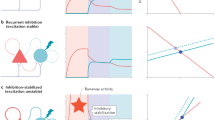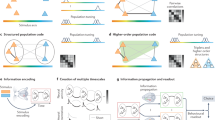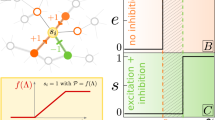Abstract
Recent years have seen a growing interest in inhibitory interneurons and their circuits. A striking property of cortical inhibition is how tightly it balances excitation. Inhibitory currents not only match excitatory currents on average, but track them on a millisecond time scale, whether they are caused by external stimuli or spontaneous fluctuations. We review, together with experimental evidence, recent theoretical approaches that investigate the advantages of such tight balance for coding and computation. These studies suggest a possible revision of the dominant view that neurons represent information with firing rates corrupted by Poisson noise. Instead, tight excitatory/inhibitory balance may be a signature of a highly cooperative code, orders of magnitude more precise than a Poisson rate code. Moreover, tight balance may provide a template that allows cortical neurons to construct high-dimensional population codes and learn complex functions of their inputs.
This is a preview of subscription content, access via your institution
Access options
Subscribe to this journal
Receive 12 print issues and online access
$209.00 per year
only $17.42 per issue
Buy this article
- Purchase on Springer Link
- Instant access to full article PDF
Prices may be subject to local taxes which are calculated during checkout




Similar content being viewed by others
References
Adrian, E.D. & Zotterman, Y. The impulses produced by sensory nerve-endings: Part II. The response of a single end-organ. J. Physiol. (Lond.) 61, 151–171 (1926).
Softky, W.R. & Koch, C. The highly irregular firing of cortical cells is inconsistent with temporal integration of random EPSPs. J. Neurosci. 13, 334–350 (1993).
Perkel, D.H. & Bullock, T.H. Neural coding. Neurosci. Res. Program Bull. 6, 220–349 (1968).
Abeles, M. Role of the cortical neuron: integrator or coincidence detector? Isr. J. Med. Sci. 18, 83–92 (1982).
Hopfield, J.J. Pattern recognition computation using action potential timing for stimulus representation. Nature 376, 33–36 (1995).
Rieke, F., Warland, D., de Ruyter van Steveninck, R. & Bialek, W. Spikes: Exploring the Neural Code (MIT Press, 1997).
Fiser, J., Berkes, P., Orbán, G. & Lengyel, M. Statistically optimal perception and learning: from behavior to neural representations. Trends Cogn. Sci. 14, 119–130 (2010).
Shadlen, M.N. & Newsome, W.T. Noise, neural codes and cortical organization. Curr. Opin. Neurobiol. 4, 569–579 (1994).
van Vreeswijk, C. & Sompolinsky, H. Chaos in neuronal networks with balanced excitatory and inhibitory activity. Science 274, 1724–1726 (1996).
Amit, D.J. & Brunel, N. Model of global spontaneous activity and local structured activity during delay periods in the cerebral cortex. Cereb. Cortex 7, 237–252 (1997).
Shadlen, M.N. & Newsome, W.T. The variable discharge of cortical neurons: implications for connectivity, computation, and information coding. J. Neurosci. 18, 3870–3896 (1998).
Brunel, N. Dynamics of sparsely connected networks of excitatory and inhibitory spiking neurons. J. Comput. Neurosci. 8, 183–208 (2000).
Shu, Y., Hasenstaub, A. & McCormick, D.A. Turning on and off recurrent balanced cortical activity. Nature 423, 288–293 (2003).
Wehr, M. & Zador, A.M. Balanced inhibition underlies tuning and sharpens spike timing in auditory cortex. Nature 426, 442–446 (2003).
Isaacson, J.S. & Scanziani, M. How inhibition shapes cortical activity. Neuron 72, 231–243 (2011).
Boerlin, M., Machens, C.K. & Denève, S. Predictive coding of dynamical variables in balanced spiking networks. PLoS Comput. Biol. 9, e1003258 (2013).
Boerlin, M. & Denève, S. Spike-based population coding and working memory. PLoS Comput. Biol. 7, e1001080 (2011).
Bourdoukan, R., Barrett, D., Deneve, S. & Machens, C.K. Learning optimal spike-based representations. In Advances in Neural Information Processing Systems (eds. Pereira, F., Burges, C.J.C., Bottou, L. & Weinberger, K.Q.) 2285–2293 (MIT Press, 2012).
Barrett, D.G., Deneve, S. & Machens, C.K. Firing rate predictions in optimal balanced networks. In Advances in Neural Information Processing Systems (eds. Pereira, F., Burges, C.J.C., Bottou, L. & Weinberger, K.Q.) 1538–1546 (MIT Press, 2013).
Thalmeier, D., Uhlmann, M., Kappen, H.J. & Memmesheimer, R.-M. Learning universal computations with spikes. Preprint at http://arxiv.org/abs/1505.07866 (2015).
Moreno-Bote, R. & Drugowitsch, J. Causal inference and explaining away in a spiking network. Sci. Rep. 5, 17531 (2015).
van Vreeswijk, C. & Sompolinsky, H. Chaotic balanced state in a model of cortical circuits. Neural Comput. 10, 1321–1371 (1998).
Monteforte, M. & Wolf, F. Dynamical entropy production in spiking neuron networks in the balanced state. Phys. Rev. Lett. 105, 268104 (2010).
London, M., Roth, A., Beeren, L., Häusser, M. & Latham, P.E. Sensitivity to perturbations in vivo implies high noise and suggests rate coding in cortex. Nature 466, 123–127 (2010).
Monier, C., Fournier, J. & Frégnac, Y. In vitro and in vivo measures of evoked excitatory and inhibitory conductance dynamics in sensory cortices. J. Neurosci. Methods 169, 323–365 (2008).
Haider, B., Duque, A., Hasenstaub, A.R. & McCormick, D.A. Neocortical network activity in vivo is generated through a dynamic balance of excitation and inhibition. J. Neurosci. 26, 4535–4545 (2006).
Xue, M., Atallah, B.V. & Scanziani, M. Equalizing excitation-inhibition ratios across visual cortical neurons. Nature 511, 596–600 (2014).
Destexhe, A., Rudolph, M. & Paré, D. The high-conductance state of neocortical neurons in vivo. Nat. Rev. Neurosci. 4, 739–751 (2003).
Anderson, J.S., Carandini, M. & Ferster, D. Orientation tuning of input conductance, excitation, and inhibition in cat primary visual cortex. J. Neurophysiol. 84, 909–926 (2000).
Martinez, L.M., Alonso, J.M., Reid, R.C. & Hirsch, J.A. Laminar processing of stimulus orientation in cat visual cortex. J. Physiol. (Lond.) 540, 321–333 (2002).
Tan, A.Y., Zhang, L.I., Merzenich, M.M. & Schreiner, C.E. Tone-evoked excitatory and inhibitory synaptic conductances of primary auditory cortex neurons. J. Neurophysiol. 92, 630–643 (2004).
Tan, A.Y., Brown, B.D., Scholl, B., Mohanty, D. & Priebe, N.J. Orientation selectivity of synaptic input to neurons in mouse and cat primary visual cortex. J. Neurosci. 31, 12339–12350 (2011).
Tan, A.Y. & Wehr, M. Balanced tone-evoked synaptic excitation and inhibition in mouse auditory cortex. Neuroscience 163, 1302–1315 (2009).
Wilent, W.B. & Contreras, D. Dynamics of excitation and inhibition underlying stimulus selectivity in rat somatosensory cortex. Nat. Neurosci. 8, 1364–1370 (2005).
Liu, B.H. et al. Broad inhibition sharpens orientation selectivity by expanding input dynamic range in mouse simple cells. Neuron 71, 542–554 (2011).
Wu, G.K., Arbuckle, R., Liu, B.H., Tao, H.W. & Zhang, L.I. Lateral sharpening of cortical frequency tuning by approximately balanced inhibition. Neuron 58, 132–143 (2008).
Cardin, J.A., Palmer, L.A. & Contreras, D. Stimulus feature selectivity in excitatory and inhibitory neurons in primary visual cortex. J. Neurosci. 27, 10333–10344 (2007).
Runyan, C.A. et al. Response features of parvalbumin-expressing interneurons suggest precise roles for subtypes of inhibition in visual cortex. Neuron 67, 847–857 (2010).
Liu, B.H. et al. Visual receptive field structure of cortical inhibitory neurons revealed by two-photon imaging guided recording. J. Neurosci. 29, 10520–10532 (2009).
Kerlin, A.M., Andermann, M.L., Berezovskii, V.K. & Reid, R.C. Broadly tuned response properties of diverse inhibitory neuron subtypes in mouse visual cortex. Neuron 67, 858–871 (2010).
Niell, C.M. & Stryker, M.P. Modulation of visual responses by behavioral state in mouse visual cortex. Neuron 65, 472–479 (2010).
Poo, C. & Isaacson, J.S. Odor representations in olfactory cortex: “sparse” coding, global inhibition, and oscillations. Neuron 62, 850–861 (2009).
D'amour, J.A. & Froemke, R.C. Inhibitory and excitatory spike-timing-dependent plasticity in the auditory cortex. Neuron 86, 514–528 (2015).
Dorrn, A.L., Yuan, K., Barker, A.J., Schreiner, C.E. & Froemke, R.C. Developmental sensory experience balances cortical excitation and inhibition. Nature 465, 932–936 (2010).
Froemke, R.C., Merzenich, M.M. & Schreiner, C.E. A synaptic memory trace for cortical receptive field plasticity. Nature 450, 425–429 (2007).
Marlin, B.J., Mitre, M., D'amour, J.A., Chao, M.V. & Froemke, R.C. Oxytocin enables maternal behaviour by balancing cortical inhibition. Nature 520, 499–504 (2015).
Froemke, R.C. et al. Long-term modification of cortical synapses improves sensory perception. Nat. Neurosci. 16, 79–88 (2013).
Graupner, M. & Reyes, A.D. Synaptic input correlations leading to membrane potential decorrelation of spontaneous activity in cortex. J. Neurosci. 33, 15075–15085 (2013).
Okun, M. & Lampl, I. Instantaneous correlation of excitation and inhibition during ongoing and sensory-evoked activities. Nat. Neurosci. 11, 535–537 (2008).
Tan, A.Y.Y., Andoni, S. & Priebe, N.J. A spontaneous state of weakly correlated synaptic excitation and inhibition in visual cortex. Neuroscience 247, 364–375 (2013).
Salkoff, D.B., Zagha, E., Yüzgeç, Ö. & McCormick, D.A. Synaptic mechanisms of tight spike synchrony at gamma frequency in cerebral cortex. J. Neurosci. 35, 10236–10251 (2015).
Atallah, B.V. & Scanziani, M. Instantaneous modulation of gamma oscillation frequency by balancing excitation with inhibition. Neuron 62, 566–577 (2009).
Cohen, M.R. & Kohn, A. Measuring and interpreting neuronal correlations. Nat. Neurosci. 14, 811–819 (2011).
Yu, J. & Ferster, D. Membrane potential synchrony in primary visual cortex during sensory stimulation. Neuron 68, 1187–1201 (2010).
Gentet, L.J., Avermann, M., Matyas, F., Staiger, J.F. & Petersen, C.C. Membrane potential dynamics of GABAergic neurons in the barrel cortex of behaving mice. Neuron 65, 422–435 (2010).
Renart, A. et al. The asynchronous state in cortical circuits. Science 327, 587–590 (2010).
Vogels, T.P., Sprekeler, H., Zenke, F., Clopath, C. & Gerstner, W. Inhibitory plasticity balances excitation and inhibition in sensory pathways and memory networks. Science 334, 1569–1573 (2011).
Barrett, D.G.T., Deneve, S. & Machens, C.K. Optimal compensation for neuron death. Preprint at http://biorxiv.org/content/early/2015/10/20/029512 (2015).
Schwemmer, M.A., Fairhall, A.L., Denéve, S. & Shea-Brown, E.T. Constructing precisely computing networks with biophysical spiking neurons. J. Neurosci. 35, 10112–10134 (2015).
Chalk, M., Gutkin, B. & Deneve, S. Neural oscillations as a signature of efficient coding in the presence of synaptic delays. Preprint at doi:10.1101/034736 (2015).
Dayan, P. & Abbott, L.F. Theoretical Neuroscience vol. 806 (MIT Press, 2001).
Jaeger, H. The echo state approach to analysing and training recurrent neural networks–with an erratum note. GMD Technical Report 148:34 (German National Research Center for Information Technology, Bonn, 2001).
Maass, W., Natschläger, T. & Markram, H. Real-time computing without stable states: a new framework for neural computation based on perturbations. Neural Comput. 14, 2531–2560 (2002).
Compte, A., Brunel, N., Goldman-Rakic, P.S. & Wang, X.J. Synaptic mechanisms and network dynamics underlying spatial working memory in a cortical network model. Cereb. Cortex 10, 910–923 (2000).
Hansel, D. & Mato, G. Short-term plasticity explains irregular persistent activity in working memory tasks. J. Neurosci. 33, 133–149 (2013).
Murphy, B.K. & Miller, K.D. Balanced amplification: a new mechanism of selective amplification of neural activity patterns. Neuron 61, 635–648 (2009).
Hennequin, G., Vogels, T.P. & Gerstner, W. Optimal control of transient dynamics in balanced networks supports generation of complex movements. Neuron 82, 1394–1406 (2014).
Churchland, M.M. et al. Neural population dynamics during reaching. Nature 487, 51–56 (2012).
Bourdoukan, R. & Deneve, S. Enforcing balance allows local supervised learning in spiking recurrent networks. In Advances in Neural Information Processing Systems (in the press).
Abbott, L.F., DePasquale, B. & Memmesheimer, R.-M. Building functional networks of spiking model. Nat. Neurosci. 19, 350–355 (2016).
Poirazi, P., Brannon, T. & Mel, B.W. Pyramidal neuron as two-layer neural network. Neuron 37, 989–999 (2003).
Lim, S. & Goldman, M.S. Balanced cortical microcircuitry for spatial working memory based on corrective feedback control. J. Neurosci. 34, 6790–6806 (2014).
Lim, S. & Goldman, M.S. Balanced cortical microcircuitry for maintaining information in working memory. Nat. Neurosci. 16, 1306–1314 (2013).
Mello, G.B., Soares, S. & Paton, J.J. A scalable population code for time in the striatum. Curr. Biol. 25, 1113–1122 (2015).
Harvey, C.D., Coen, P. & Tank, D.W. Choice-specific sequences in parietal cortex during a virtual-navigation decision task. Nature 484, 62–68 (2012).
Stettler, D.D. & Axel, R. Representations of odor in the piriform cortex. Neuron 63, 854–864 (2009).
Monier, C., Chavane, F., Baudot, P., Graham, L.J. & Frégnac, Y. Orientation and direction selectivity of synaptic inputs in visual cortical neurons: a diversity of combinations produces spike tuning. Neuron 37, 663–680 (2003).
Haider, B., Häusser, M. & Carandini, M. Inhibition dominates sensory responses in the awake cortex. Nature 493, 97–100 (2013).
Zhou, M. et al. Scaling down of balanced excitation and inhibition by active behavioral states in auditory cortex. Nat. Neurosci. 17, 841–850 (2014).
Hubel, D.H. & Wiesel, T.N. Receptive fields, binocular interaction and functional architecture in the cat's visual cortex. J. Physiol. (Lond.) 160, 106–154 (1962).
Ohki, K., Chung, S., Ch'ng, Y.H., Kara, P. & Reid, R.C. Functional imaging with cellular resolution reveals precise micro-architecture in visual cortex. Nature 433, 597–603 (2005).
Fino, E. & Yuste, R. Dense inhibitory connectivity in neocortex. Neuron 69, 1188–1203 (2011).
Packer, A.M., McConnell, D.J., Fino, E. & Yuste, R. Axo-dendritic overlap and laminar projection can explain interneuron connectivity to pyramidal cells. Cereb. Cortex 23, 2790–2802 (2013).
Ren, M., Yoshimura, Y., Takada, N., Horibe, S. & Komatsu, Y. Specialized inhibitory synaptic actions between nearby neocortical pyramidal neurons. Science 316, 758–761 (2007).
Bock, D.D. et al. Network anatomy and in vivo physiology of visual cortical neurons. Nature 471, 177–182 (2011).
Acknowledgements
We thank A. Renart and B. Atallah for discussions.
Author information
Authors and Affiliations
Corresponding authors
Ethics declarations
Competing interests
The authors declare no competing financial interests.
Rights and permissions
About this article
Cite this article
Denève, S., Machens, C. Efficient codes and balanced networks. Nat Neurosci 19, 375–382 (2016). https://doi.org/10.1038/nn.4243
Received:
Accepted:
Published:
Issue Date:
DOI: https://doi.org/10.1038/nn.4243
This article is cited by
-
The logic of recurrent circuits in the primary visual cortex
Nature Neuroscience (2024)
-
On the physiological and structural contributors to the overall balance of excitation and inhibition in local cortical networks
Journal of Computational Neuroscience (2024)
-
Complexity and 1/f slope jointly reflect brain states
Scientific Reports (2023)
-
Inhibitory neurons control the consolidation of neural assemblies via adaptation to selective stimuli
Scientific Reports (2023)
-
Cortical excitation/inhibition ratios in patients with major depression treated with electroconvulsive therapy: an EEG analysis
European Archives of Psychiatry and Clinical Neuroscience (2023)



